Advanced Financial Accounting Report: Woolworths Intangible Assets
VerifiedAdded on 2020/02/19
|11
|2346
|96
Report
AI Summary
This report provides an in-depth analysis of intangible assets within the context of advanced financial accounting, specifically focusing on the practices of Woolworths. It begins by defining intangible assets and outlining the criteria for their recognition according to AASB standards, including the expected future economic benefits and reliable measurement of cost. The report then delves into the accounting treatment of intangible assets, covering initial recognition at cost, the inclusion of direct costs like registration fees and employee benefits, and the classification of costs into development and research phases. It examines amortization and impairment testing, including fair value determination and revaluation procedures. The report also explores alternative approaches to standard setting regarding intangible assets and discusses the accounting for assets with indefinite useful lives, derecognition rules, and disclosure requirements. The report then analyzes Woolworths' intangible assets, including goodwill, brand names, and licenses, as reported in their 2016 annual report. It details the accounting policies for goodwill and other intangible assets, including impairment assessments and the determination of useful lives. Finally, the report provides a recommendation for improving the disclosure of intangible assets, suggesting specific guidance on report types and information placement to enhance user accessibility.
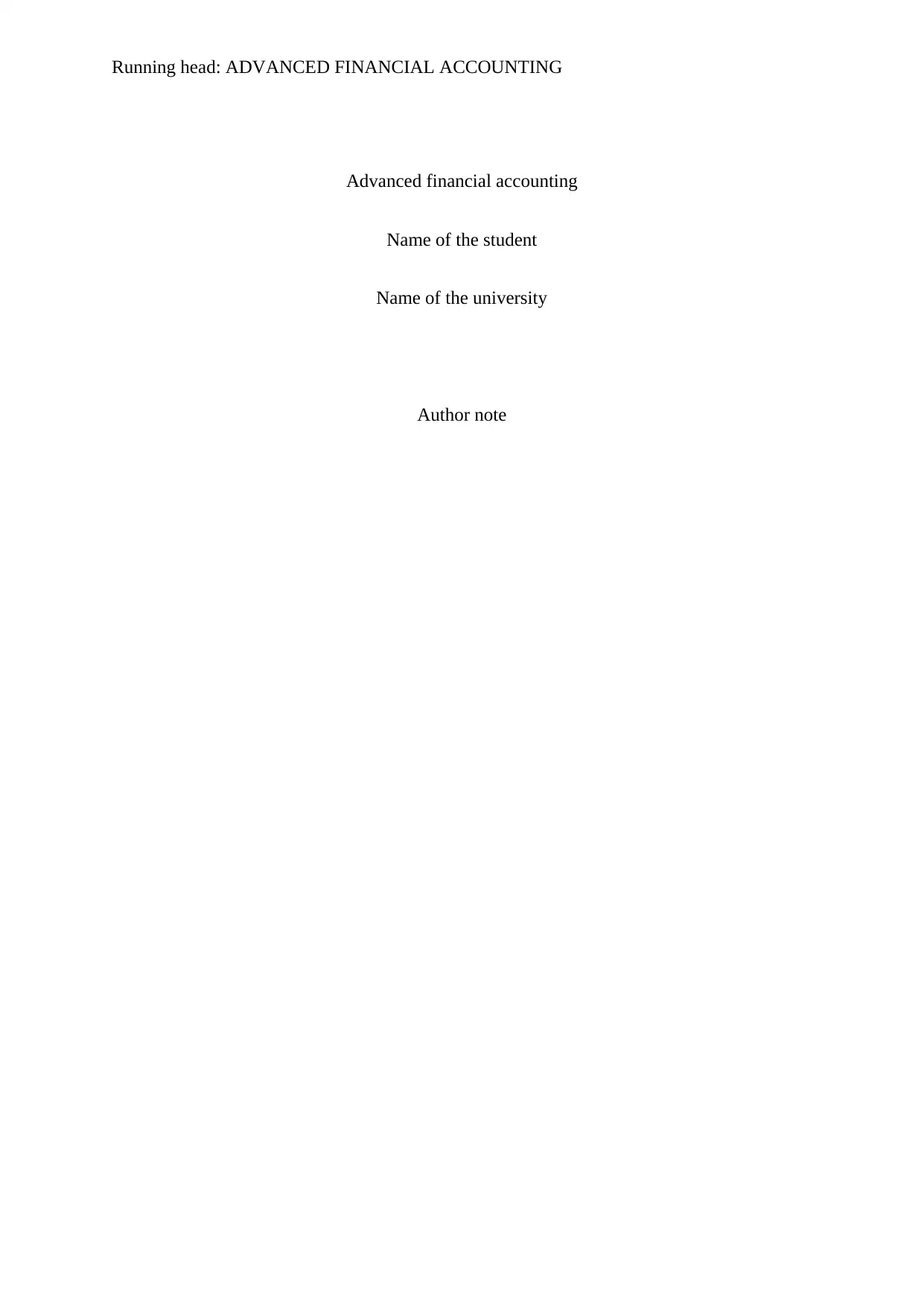
Running head: ADVANCED FINANCIAL ACCOUNTING
Advanced financial accounting
Name of the student
Name of the university
Author note
Advanced financial accounting
Name of the student
Name of the university
Author note
Paraphrase This Document
Need a fresh take? Get an instant paraphrase of this document with our AI Paraphraser
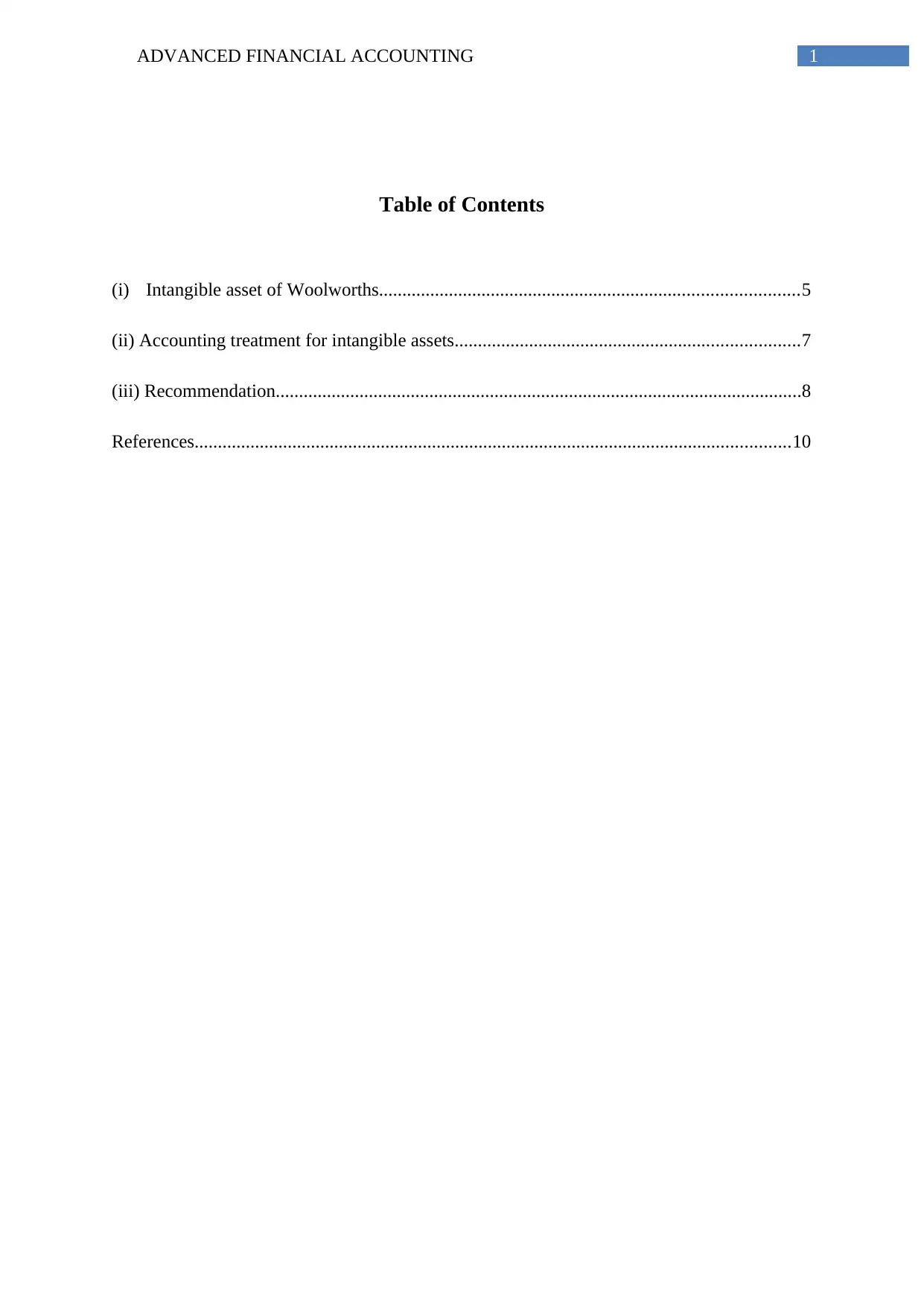
1ADVANCED FINANCIAL ACCOUNTING
Table of Contents
(i) Intangible asset of Woolworths..........................................................................................5
(ii) Accounting treatment for intangible assets..........................................................................7
(iii) Recommendation.................................................................................................................8
References................................................................................................................................10
Table of Contents
(i) Intangible asset of Woolworths..........................................................................................5
(ii) Accounting treatment for intangible assets..........................................................................7
(iii) Recommendation.................................................................................................................8
References................................................................................................................................10
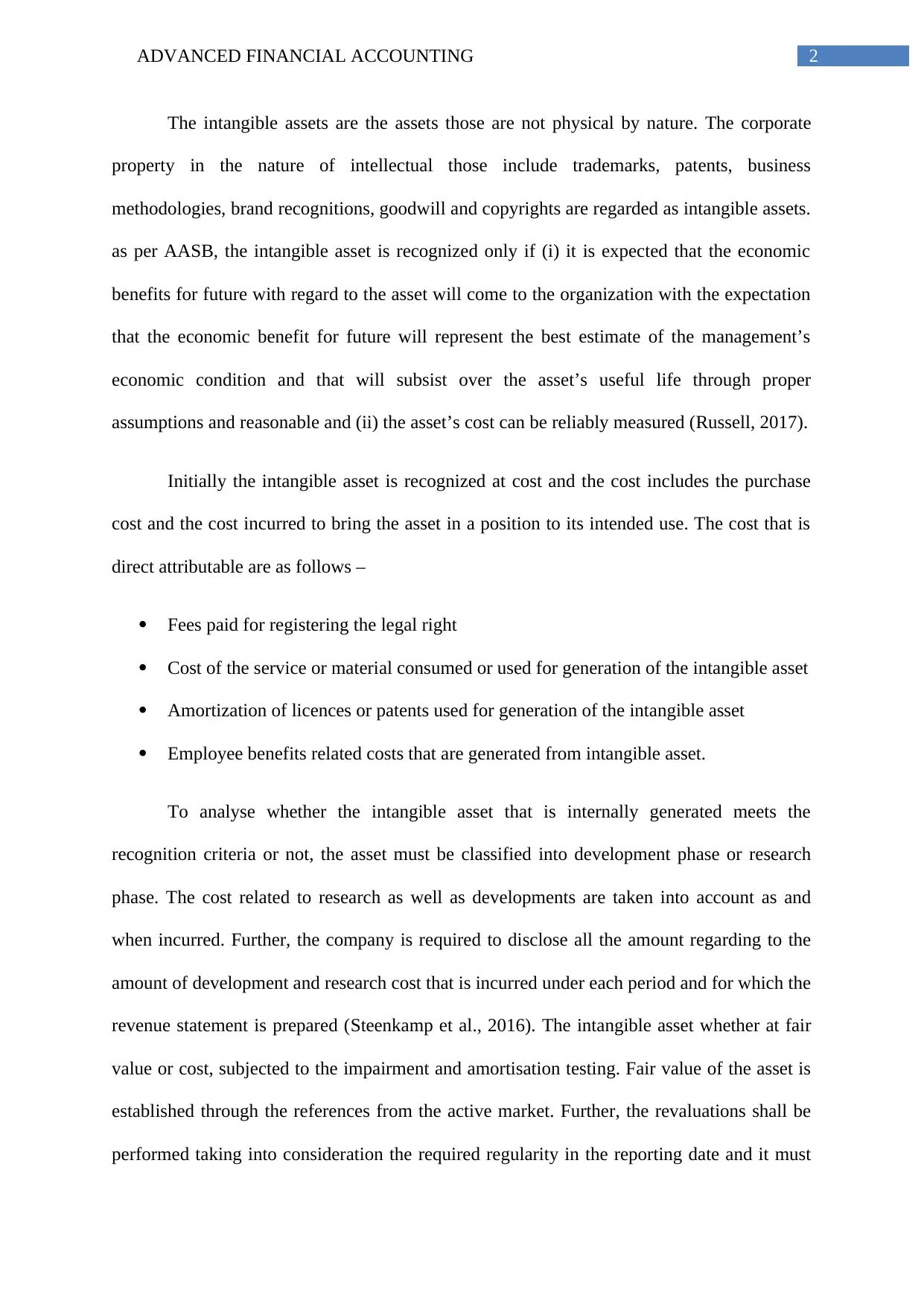
2ADVANCED FINANCIAL ACCOUNTING
The intangible assets are the assets those are not physical by nature. The corporate
property in the nature of intellectual those include trademarks, patents, business
methodologies, brand recognitions, goodwill and copyrights are regarded as intangible assets.
as per AASB, the intangible asset is recognized only if (i) it is expected that the economic
benefits for future with regard to the asset will come to the organization with the expectation
that the economic benefit for future will represent the best estimate of the management’s
economic condition and that will subsist over the asset’s useful life through proper
assumptions and reasonable and (ii) the asset’s cost can be reliably measured (Russell, 2017).
Initially the intangible asset is recognized at cost and the cost includes the purchase
cost and the cost incurred to bring the asset in a position to its intended use. The cost that is
direct attributable are as follows –
Fees paid for registering the legal right
Cost of the service or material consumed or used for generation of the intangible asset
Amortization of licences or patents used for generation of the intangible asset
Employee benefits related costs that are generated from intangible asset.
To analyse whether the intangible asset that is internally generated meets the
recognition criteria or not, the asset must be classified into development phase or research
phase. The cost related to research as well as developments are taken into account as and
when incurred. Further, the company is required to disclose all the amount regarding to the
amount of development and research cost that is incurred under each period and for which the
revenue statement is prepared (Steenkamp et al., 2016). The intangible asset whether at fair
value or cost, subjected to the impairment and amortisation testing. Fair value of the asset is
established through the references from the active market. Further, the revaluations shall be
performed taking into consideration the required regularity in the reporting date and it must
The intangible assets are the assets those are not physical by nature. The corporate
property in the nature of intellectual those include trademarks, patents, business
methodologies, brand recognitions, goodwill and copyrights are regarded as intangible assets.
as per AASB, the intangible asset is recognized only if (i) it is expected that the economic
benefits for future with regard to the asset will come to the organization with the expectation
that the economic benefit for future will represent the best estimate of the management’s
economic condition and that will subsist over the asset’s useful life through proper
assumptions and reasonable and (ii) the asset’s cost can be reliably measured (Russell, 2017).
Initially the intangible asset is recognized at cost and the cost includes the purchase
cost and the cost incurred to bring the asset in a position to its intended use. The cost that is
direct attributable are as follows –
Fees paid for registering the legal right
Cost of the service or material consumed or used for generation of the intangible asset
Amortization of licences or patents used for generation of the intangible asset
Employee benefits related costs that are generated from intangible asset.
To analyse whether the intangible asset that is internally generated meets the
recognition criteria or not, the asset must be classified into development phase or research
phase. The cost related to research as well as developments are taken into account as and
when incurred. Further, the company is required to disclose all the amount regarding to the
amount of development and research cost that is incurred under each period and for which the
revenue statement is prepared (Steenkamp et al., 2016). The intangible asset whether at fair
value or cost, subjected to the impairment and amortisation testing. Fair value of the asset is
established through the references from the active market. Further, the revaluations shall be
performed taking into consideration the required regularity in the reporting date and it must
⊘ This is a preview!⊘
Do you want full access?
Subscribe today to unlock all pages.

Trusted by 1+ million students worldwide
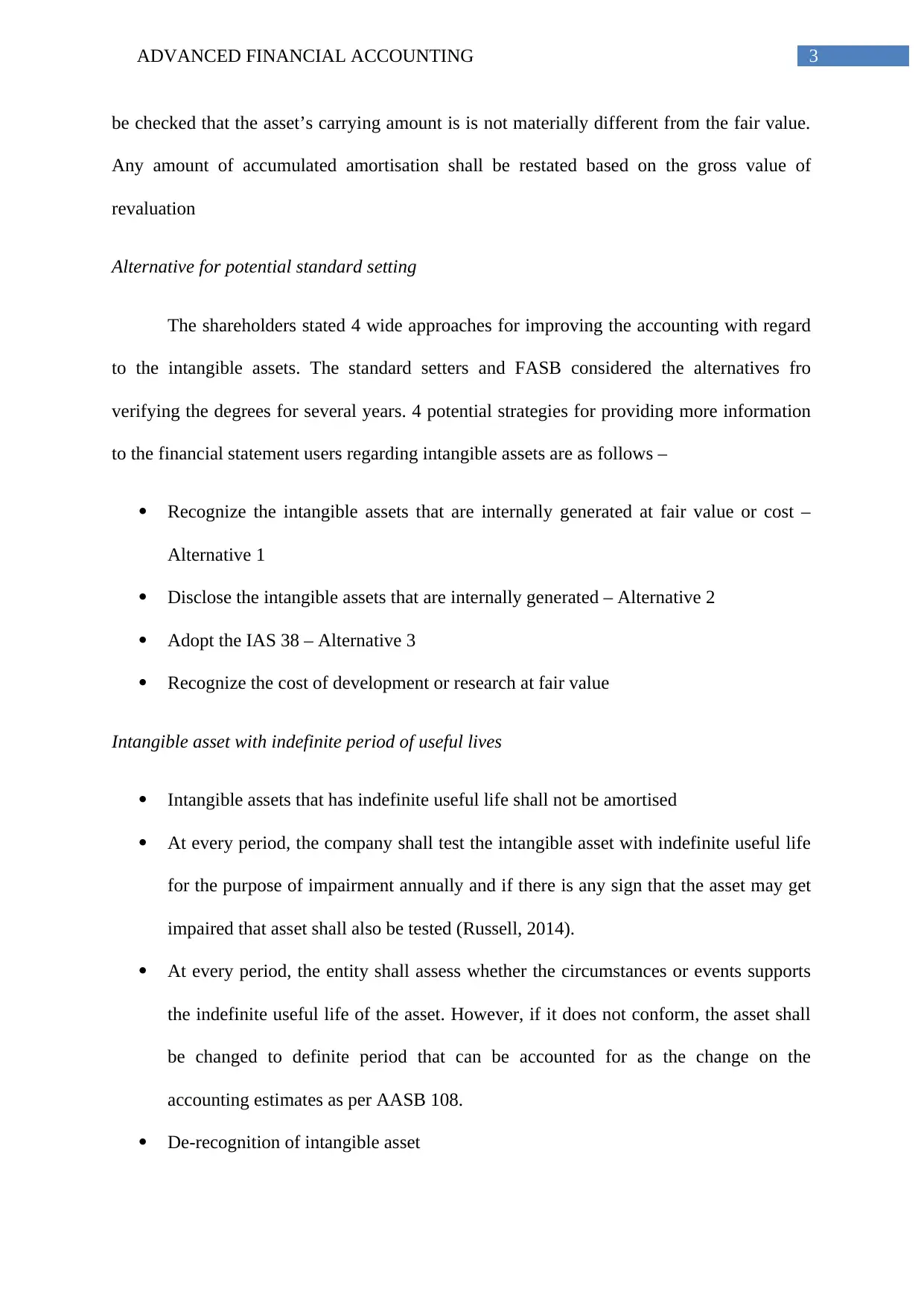
3ADVANCED FINANCIAL ACCOUNTING
be checked that the asset’s carrying amount is is not materially different from the fair value.
Any amount of accumulated amortisation shall be restated based on the gross value of
revaluation
Alternative for potential standard setting
The shareholders stated 4 wide approaches for improving the accounting with regard
to the intangible assets. The standard setters and FASB considered the alternatives fro
verifying the degrees for several years. 4 potential strategies for providing more information
to the financial statement users regarding intangible assets are as follows –
Recognize the intangible assets that are internally generated at fair value or cost –
Alternative 1
Disclose the intangible assets that are internally generated – Alternative 2
Adopt the IAS 38 – Alternative 3
Recognize the cost of development or research at fair value
Intangible asset with indefinite period of useful lives
Intangible assets that has indefinite useful life shall not be amortised
At every period, the company shall test the intangible asset with indefinite useful life
for the purpose of impairment annually and if there is any sign that the asset may get
impaired that asset shall also be tested (Russell, 2014).
At every period, the entity shall assess whether the circumstances or events supports
the indefinite useful life of the asset. However, if it does not conform, the asset shall
be changed to definite period that can be accounted for as the change on the
accounting estimates as per AASB 108.
De-recognition of intangible asset
be checked that the asset’s carrying amount is is not materially different from the fair value.
Any amount of accumulated amortisation shall be restated based on the gross value of
revaluation
Alternative for potential standard setting
The shareholders stated 4 wide approaches for improving the accounting with regard
to the intangible assets. The standard setters and FASB considered the alternatives fro
verifying the degrees for several years. 4 potential strategies for providing more information
to the financial statement users regarding intangible assets are as follows –
Recognize the intangible assets that are internally generated at fair value or cost –
Alternative 1
Disclose the intangible assets that are internally generated – Alternative 2
Adopt the IAS 38 – Alternative 3
Recognize the cost of development or research at fair value
Intangible asset with indefinite period of useful lives
Intangible assets that has indefinite useful life shall not be amortised
At every period, the company shall test the intangible asset with indefinite useful life
for the purpose of impairment annually and if there is any sign that the asset may get
impaired that asset shall also be tested (Russell, 2014).
At every period, the entity shall assess whether the circumstances or events supports
the indefinite useful life of the asset. However, if it does not conform, the asset shall
be changed to definite period that can be accounted for as the change on the
accounting estimates as per AASB 108.
De-recognition of intangible asset
Paraphrase This Document
Need a fresh take? Get an instant paraphrase of this document with our AI Paraphraser
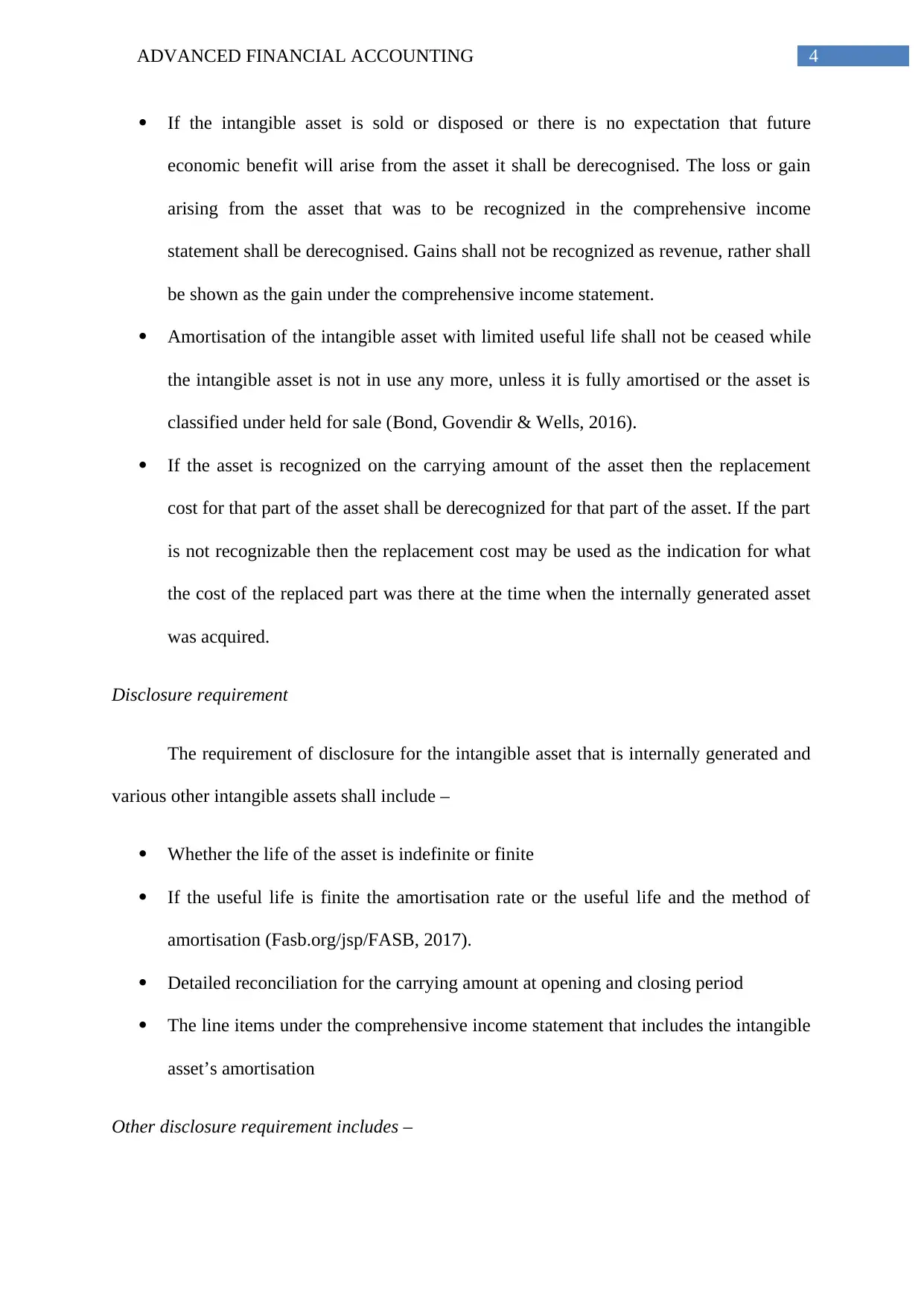
4ADVANCED FINANCIAL ACCOUNTING
If the intangible asset is sold or disposed or there is no expectation that future
economic benefit will arise from the asset it shall be derecognised. The loss or gain
arising from the asset that was to be recognized in the comprehensive income
statement shall be derecognised. Gains shall not be recognized as revenue, rather shall
be shown as the gain under the comprehensive income statement.
Amortisation of the intangible asset with limited useful life shall not be ceased while
the intangible asset is not in use any more, unless it is fully amortised or the asset is
classified under held for sale (Bond, Govendir & Wells, 2016).
If the asset is recognized on the carrying amount of the asset then the replacement
cost for that part of the asset shall be derecognized for that part of the asset. If the part
is not recognizable then the replacement cost may be used as the indication for what
the cost of the replaced part was there at the time when the internally generated asset
was acquired.
Disclosure requirement
The requirement of disclosure for the intangible asset that is internally generated and
various other intangible assets shall include –
Whether the life of the asset is indefinite or finite
If the useful life is finite the amortisation rate or the useful life and the method of
amortisation (Fasb.org/jsp/FASB, 2017).
Detailed reconciliation for the carrying amount at opening and closing period
The line items under the comprehensive income statement that includes the intangible
asset’s amortisation
Other disclosure requirement includes –
If the intangible asset is sold or disposed or there is no expectation that future
economic benefit will arise from the asset it shall be derecognised. The loss or gain
arising from the asset that was to be recognized in the comprehensive income
statement shall be derecognised. Gains shall not be recognized as revenue, rather shall
be shown as the gain under the comprehensive income statement.
Amortisation of the intangible asset with limited useful life shall not be ceased while
the intangible asset is not in use any more, unless it is fully amortised or the asset is
classified under held for sale (Bond, Govendir & Wells, 2016).
If the asset is recognized on the carrying amount of the asset then the replacement
cost for that part of the asset shall be derecognized for that part of the asset. If the part
is not recognizable then the replacement cost may be used as the indication for what
the cost of the replaced part was there at the time when the internally generated asset
was acquired.
Disclosure requirement
The requirement of disclosure for the intangible asset that is internally generated and
various other intangible assets shall include –
Whether the life of the asset is indefinite or finite
If the useful life is finite the amortisation rate or the useful life and the method of
amortisation (Fasb.org/jsp/FASB, 2017).
Detailed reconciliation for the carrying amount at opening and closing period
The line items under the comprehensive income statement that includes the intangible
asset’s amortisation
Other disclosure requirement includes –
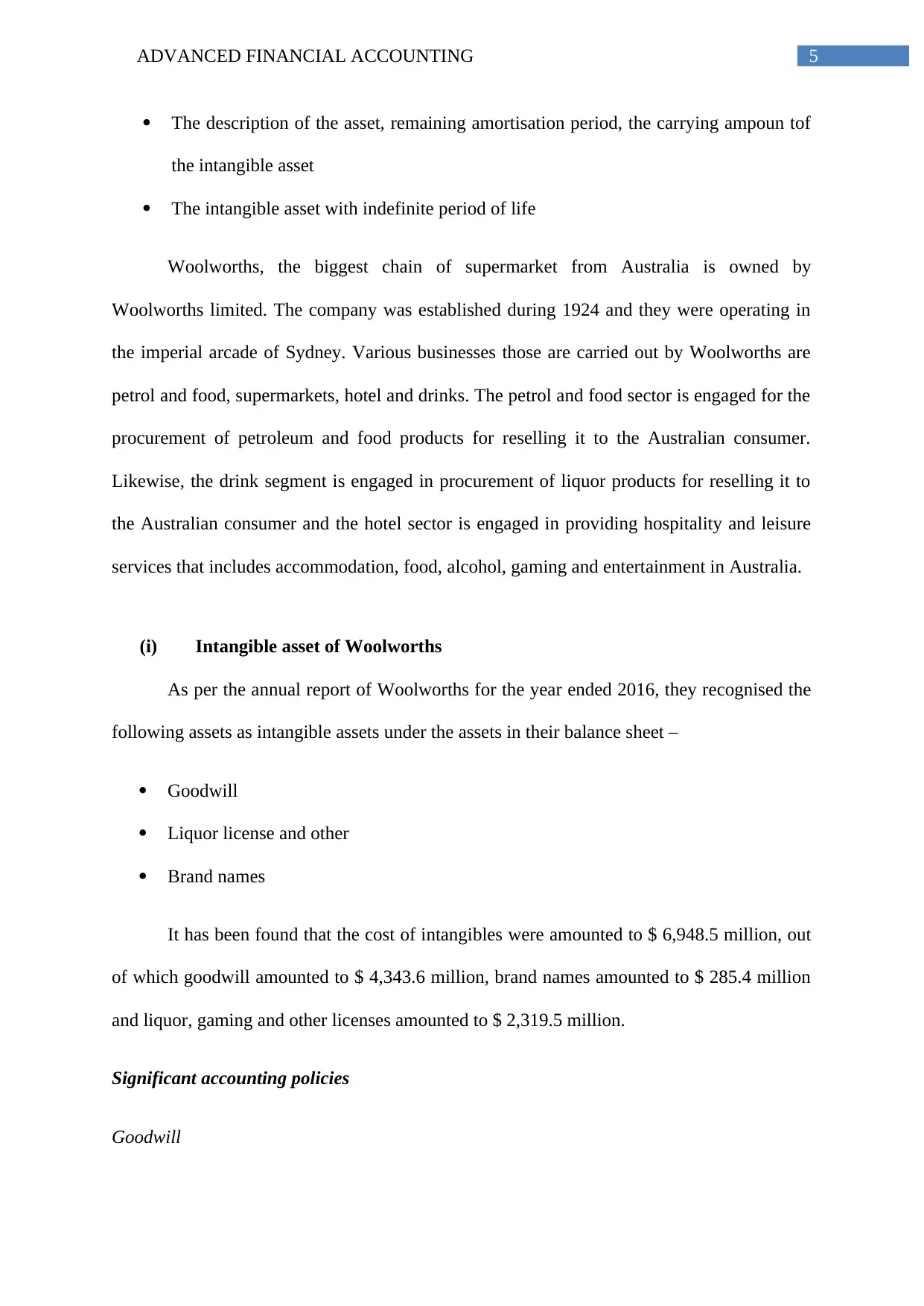
5ADVANCED FINANCIAL ACCOUNTING
The description of the asset, remaining amortisation period, the carrying ampoun tof
the intangible asset
The intangible asset with indefinite period of life
Woolworths, the biggest chain of supermarket from Australia is owned by
Woolworths limited. The company was established during 1924 and they were operating in
the imperial arcade of Sydney. Various businesses those are carried out by Woolworths are
petrol and food, supermarkets, hotel and drinks. The petrol and food sector is engaged for the
procurement of petroleum and food products for reselling it to the Australian consumer.
Likewise, the drink segment is engaged in procurement of liquor products for reselling it to
the Australian consumer and the hotel sector is engaged in providing hospitality and leisure
services that includes accommodation, food, alcohol, gaming and entertainment in Australia.
(i) Intangible asset of Woolworths
As per the annual report of Woolworths for the year ended 2016, they recognised the
following assets as intangible assets under the assets in their balance sheet –
Goodwill
Liquor license and other
Brand names
It has been found that the cost of intangibles were amounted to $ 6,948.5 million, out
of which goodwill amounted to $ 4,343.6 million, brand names amounted to $ 285.4 million
and liquor, gaming and other licenses amounted to $ 2,319.5 million.
Significant accounting policies
Goodwill
The description of the asset, remaining amortisation period, the carrying ampoun tof
the intangible asset
The intangible asset with indefinite period of life
Woolworths, the biggest chain of supermarket from Australia is owned by
Woolworths limited. The company was established during 1924 and they were operating in
the imperial arcade of Sydney. Various businesses those are carried out by Woolworths are
petrol and food, supermarkets, hotel and drinks. The petrol and food sector is engaged for the
procurement of petroleum and food products for reselling it to the Australian consumer.
Likewise, the drink segment is engaged in procurement of liquor products for reselling it to
the Australian consumer and the hotel sector is engaged in providing hospitality and leisure
services that includes accommodation, food, alcohol, gaming and entertainment in Australia.
(i) Intangible asset of Woolworths
As per the annual report of Woolworths for the year ended 2016, they recognised the
following assets as intangible assets under the assets in their balance sheet –
Goodwill
Liquor license and other
Brand names
It has been found that the cost of intangibles were amounted to $ 6,948.5 million, out
of which goodwill amounted to $ 4,343.6 million, brand names amounted to $ 285.4 million
and liquor, gaming and other licenses amounted to $ 2,319.5 million.
Significant accounting policies
Goodwill
⊘ This is a preview!⊘
Do you want full access?
Subscribe today to unlock all pages.

Trusted by 1+ million students worldwide
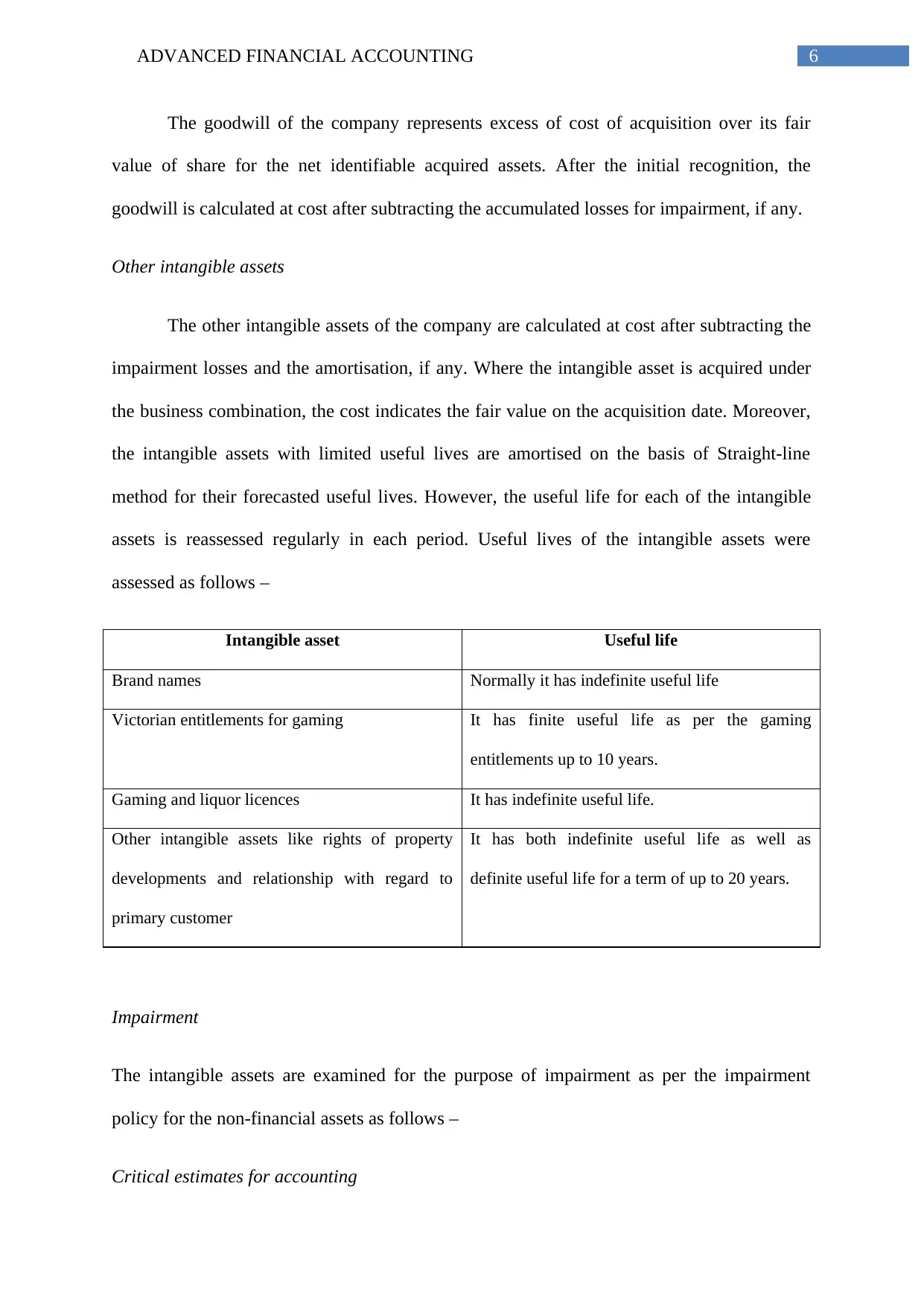
6ADVANCED FINANCIAL ACCOUNTING
The goodwill of the company represents excess of cost of acquisition over its fair
value of share for the net identifiable acquired assets. After the initial recognition, the
goodwill is calculated at cost after subtracting the accumulated losses for impairment, if any.
Other intangible assets
The other intangible assets of the company are calculated at cost after subtracting the
impairment losses and the amortisation, if any. Where the intangible asset is acquired under
the business combination, the cost indicates the fair value on the acquisition date. Moreover,
the intangible assets with limited useful lives are amortised on the basis of Straight-line
method for their forecasted useful lives. However, the useful life for each of the intangible
assets is reassessed regularly in each period. Useful lives of the intangible assets were
assessed as follows –
Intangible asset Useful life
Brand names Normally it has indefinite useful life
Victorian entitlements for gaming It has finite useful life as per the gaming
entitlements up to 10 years.
Gaming and liquor licences It has indefinite useful life.
Other intangible assets like rights of property
developments and relationship with regard to
primary customer
It has both indefinite useful life as well as
definite useful life for a term of up to 20 years.
Impairment
The intangible assets are examined for the purpose of impairment as per the impairment
policy for the non-financial assets as follows –
Critical estimates for accounting
The goodwill of the company represents excess of cost of acquisition over its fair
value of share for the net identifiable acquired assets. After the initial recognition, the
goodwill is calculated at cost after subtracting the accumulated losses for impairment, if any.
Other intangible assets
The other intangible assets of the company are calculated at cost after subtracting the
impairment losses and the amortisation, if any. Where the intangible asset is acquired under
the business combination, the cost indicates the fair value on the acquisition date. Moreover,
the intangible assets with limited useful lives are amortised on the basis of Straight-line
method for their forecasted useful lives. However, the useful life for each of the intangible
assets is reassessed regularly in each period. Useful lives of the intangible assets were
assessed as follows –
Intangible asset Useful life
Brand names Normally it has indefinite useful life
Victorian entitlements for gaming It has finite useful life as per the gaming
entitlements up to 10 years.
Gaming and liquor licences It has indefinite useful life.
Other intangible assets like rights of property
developments and relationship with regard to
primary customer
It has both indefinite useful life as well as
definite useful life for a term of up to 20 years.
Impairment
The intangible assets are examined for the purpose of impairment as per the impairment
policy for the non-financial assets as follows –
Critical estimates for accounting
Paraphrase This Document
Need a fresh take? Get an instant paraphrase of this document with our AI Paraphraser
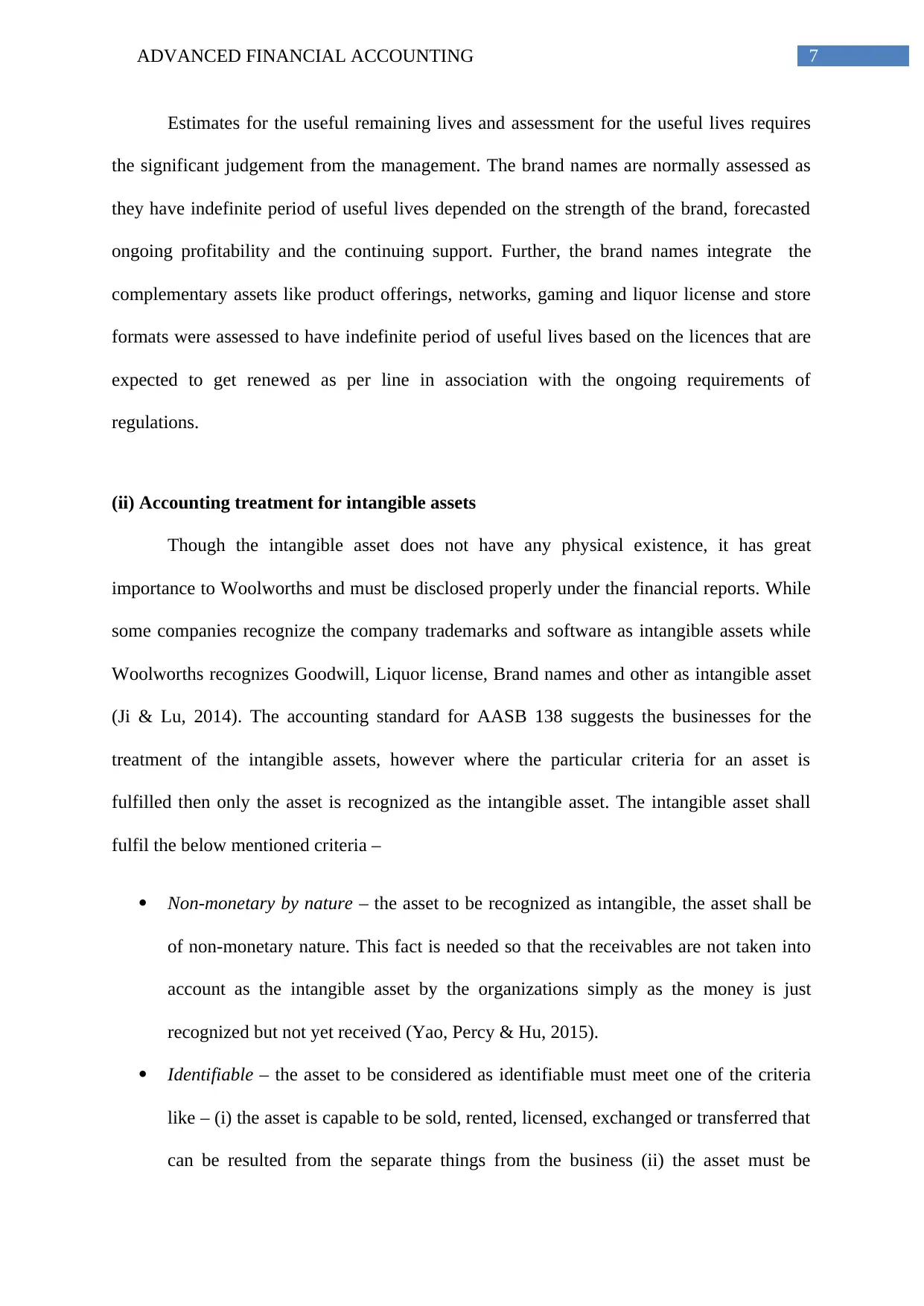
7ADVANCED FINANCIAL ACCOUNTING
Estimates for the useful remaining lives and assessment for the useful lives requires
the significant judgement from the management. The brand names are normally assessed as
they have indefinite period of useful lives depended on the strength of the brand, forecasted
ongoing profitability and the continuing support. Further, the brand names integrate the
complementary assets like product offerings, networks, gaming and liquor license and store
formats were assessed to have indefinite period of useful lives based on the licences that are
expected to get renewed as per line in association with the ongoing requirements of
regulations.
(ii) Accounting treatment for intangible assets
Though the intangible asset does not have any physical existence, it has great
importance to Woolworths and must be disclosed properly under the financial reports. While
some companies recognize the company trademarks and software as intangible assets while
Woolworths recognizes Goodwill, Liquor license, Brand names and other as intangible asset
(Ji & Lu, 2014). The accounting standard for AASB 138 suggests the businesses for the
treatment of the intangible assets, however where the particular criteria for an asset is
fulfilled then only the asset is recognized as the intangible asset. The intangible asset shall
fulfil the below mentioned criteria –
Non-monetary by nature – the asset to be recognized as intangible, the asset shall be
of non-monetary nature. This fact is needed so that the receivables are not taken into
account as the intangible asset by the organizations simply as the money is just
recognized but not yet received (Yao, Percy & Hu, 2015).
Identifiable – the asset to be considered as identifiable must meet one of the criteria
like – (i) the asset is capable to be sold, rented, licensed, exchanged or transferred that
can be resulted from the separate things from the business (ii) the asset must be
Estimates for the useful remaining lives and assessment for the useful lives requires
the significant judgement from the management. The brand names are normally assessed as
they have indefinite period of useful lives depended on the strength of the brand, forecasted
ongoing profitability and the continuing support. Further, the brand names integrate the
complementary assets like product offerings, networks, gaming and liquor license and store
formats were assessed to have indefinite period of useful lives based on the licences that are
expected to get renewed as per line in association with the ongoing requirements of
regulations.
(ii) Accounting treatment for intangible assets
Though the intangible asset does not have any physical existence, it has great
importance to Woolworths and must be disclosed properly under the financial reports. While
some companies recognize the company trademarks and software as intangible assets while
Woolworths recognizes Goodwill, Liquor license, Brand names and other as intangible asset
(Ji & Lu, 2014). The accounting standard for AASB 138 suggests the businesses for the
treatment of the intangible assets, however where the particular criteria for an asset is
fulfilled then only the asset is recognized as the intangible asset. The intangible asset shall
fulfil the below mentioned criteria –
Non-monetary by nature – the asset to be recognized as intangible, the asset shall be
of non-monetary nature. This fact is needed so that the receivables are not taken into
account as the intangible asset by the organizations simply as the money is just
recognized but not yet received (Yao, Percy & Hu, 2015).
Identifiable – the asset to be considered as identifiable must meet one of the criteria
like – (i) the asset is capable to be sold, rented, licensed, exchanged or transferred that
can be resulted from the separate things from the business (ii) the asset must be
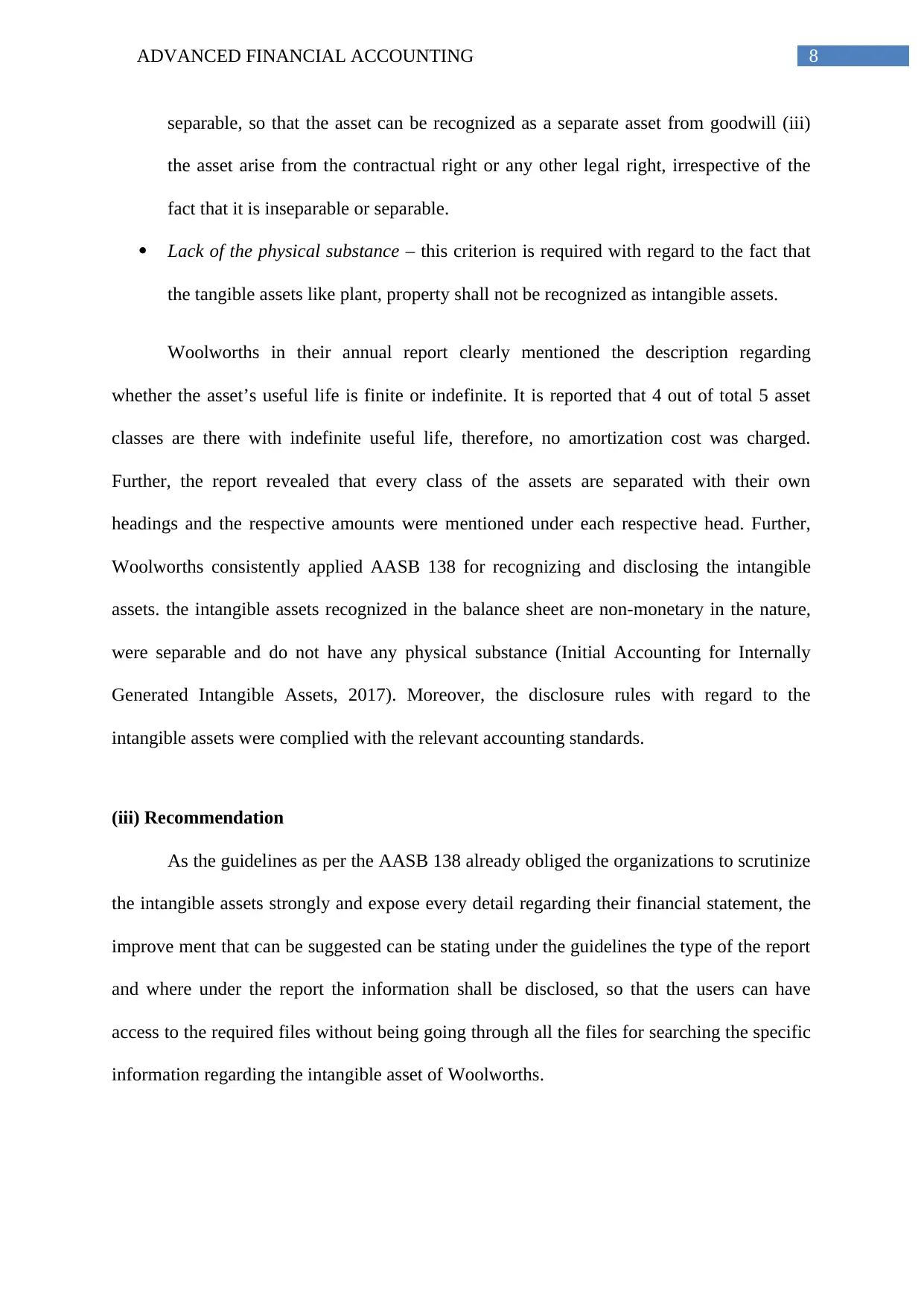
8ADVANCED FINANCIAL ACCOUNTING
separable, so that the asset can be recognized as a separate asset from goodwill (iii)
the asset arise from the contractual right or any other legal right, irrespective of the
fact that it is inseparable or separable.
Lack of the physical substance – this criterion is required with regard to the fact that
the tangible assets like plant, property shall not be recognized as intangible assets.
Woolworths in their annual report clearly mentioned the description regarding
whether the asset’s useful life is finite or indefinite. It is reported that 4 out of total 5 asset
classes are there with indefinite useful life, therefore, no amortization cost was charged.
Further, the report revealed that every class of the assets are separated with their own
headings and the respective amounts were mentioned under each respective head. Further,
Woolworths consistently applied AASB 138 for recognizing and disclosing the intangible
assets. the intangible assets recognized in the balance sheet are non-monetary in the nature,
were separable and do not have any physical substance (Initial Accounting for Internally
Generated Intangible Assets, 2017). Moreover, the disclosure rules with regard to the
intangible assets were complied with the relevant accounting standards.
(iii) Recommendation
As the guidelines as per the AASB 138 already obliged the organizations to scrutinize
the intangible assets strongly and expose every detail regarding their financial statement, the
improve ment that can be suggested can be stating under the guidelines the type of the report
and where under the report the information shall be disclosed, so that the users can have
access to the required files without being going through all the files for searching the specific
information regarding the intangible asset of Woolworths.
separable, so that the asset can be recognized as a separate asset from goodwill (iii)
the asset arise from the contractual right or any other legal right, irrespective of the
fact that it is inseparable or separable.
Lack of the physical substance – this criterion is required with regard to the fact that
the tangible assets like plant, property shall not be recognized as intangible assets.
Woolworths in their annual report clearly mentioned the description regarding
whether the asset’s useful life is finite or indefinite. It is reported that 4 out of total 5 asset
classes are there with indefinite useful life, therefore, no amortization cost was charged.
Further, the report revealed that every class of the assets are separated with their own
headings and the respective amounts were mentioned under each respective head. Further,
Woolworths consistently applied AASB 138 for recognizing and disclosing the intangible
assets. the intangible assets recognized in the balance sheet are non-monetary in the nature,
were separable and do not have any physical substance (Initial Accounting for Internally
Generated Intangible Assets, 2017). Moreover, the disclosure rules with regard to the
intangible assets were complied with the relevant accounting standards.
(iii) Recommendation
As the guidelines as per the AASB 138 already obliged the organizations to scrutinize
the intangible assets strongly and expose every detail regarding their financial statement, the
improve ment that can be suggested can be stating under the guidelines the type of the report
and where under the report the information shall be disclosed, so that the users can have
access to the required files without being going through all the files for searching the specific
information regarding the intangible asset of Woolworths.
⊘ This is a preview!⊘
Do you want full access?
Subscribe today to unlock all pages.

Trusted by 1+ million students worldwide
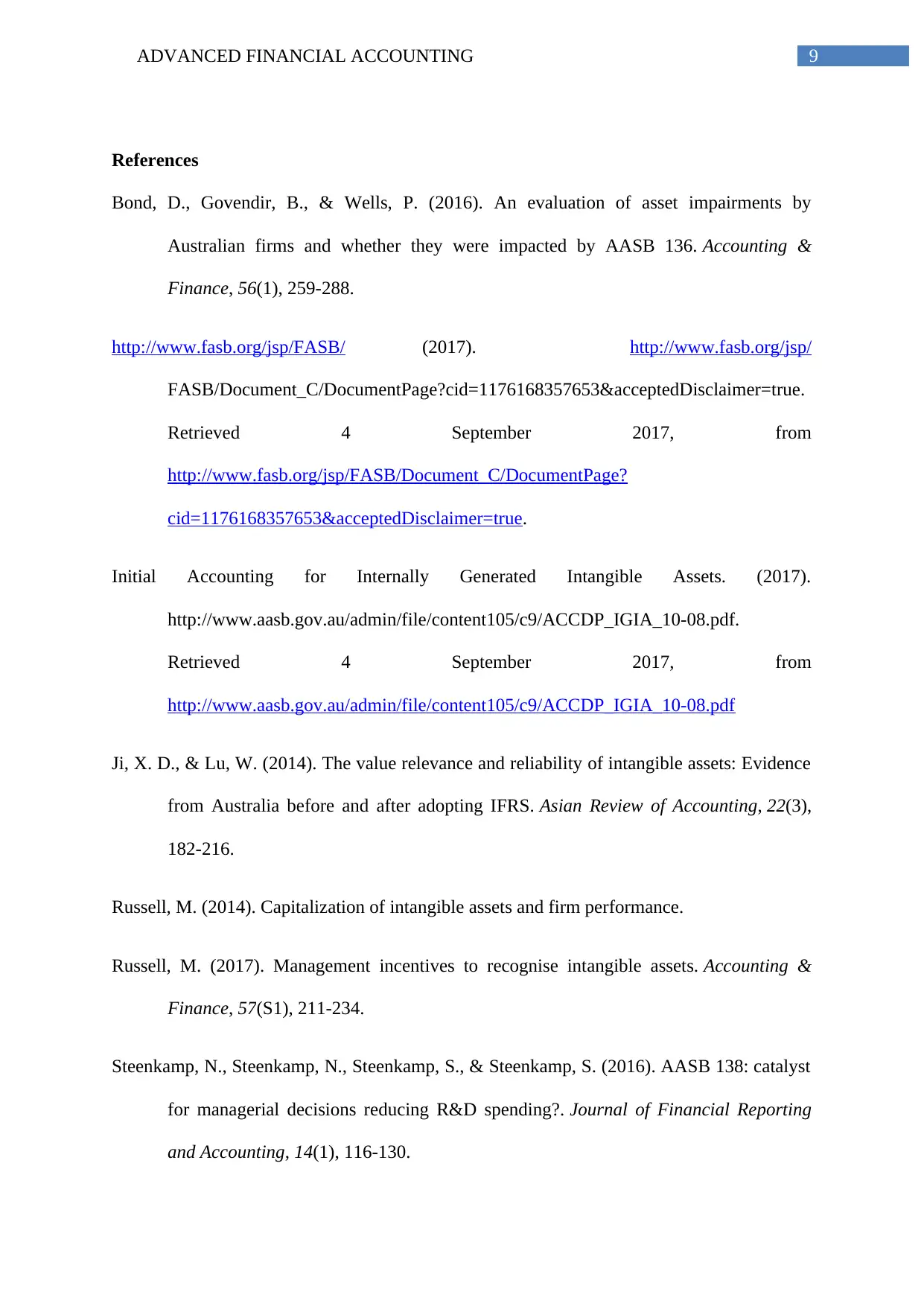
9ADVANCED FINANCIAL ACCOUNTING
References
Bond, D., Govendir, B., & Wells, P. (2016). An evaluation of asset impairments by
Australian firms and whether they were impacted by AASB 136. Accounting &
Finance, 56(1), 259-288.
http://www.fasb.org/jsp/FASB/ (2017). http://www.fasb.org/jsp/
FASB/Document_C/DocumentPage?cid=1176168357653&acceptedDisclaimer=true.
Retrieved 4 September 2017, from
http://www.fasb.org/jsp/FASB/Document_C/DocumentPage?
cid=1176168357653&acceptedDisclaimer=true.
Initial Accounting for Internally Generated Intangible Assets. (2017).
http://www.aasb.gov.au/admin/file/content105/c9/ACCDP_IGIA_10-08.pdf.
Retrieved 4 September 2017, from
http://www.aasb.gov.au/admin/file/content105/c9/ACCDP_IGIA_10-08.pdf
Ji, X. D., & Lu, W. (2014). The value relevance and reliability of intangible assets: Evidence
from Australia before and after adopting IFRS. Asian Review of Accounting, 22(3),
182-216.
Russell, M. (2014). Capitalization of intangible assets and firm performance.
Russell, M. (2017). Management incentives to recognise intangible assets. Accounting &
Finance, 57(S1), 211-234.
Steenkamp, N., Steenkamp, N., Steenkamp, S., & Steenkamp, S. (2016). AASB 138: catalyst
for managerial decisions reducing R&D spending?. Journal of Financial Reporting
and Accounting, 14(1), 116-130.
References
Bond, D., Govendir, B., & Wells, P. (2016). An evaluation of asset impairments by
Australian firms and whether they were impacted by AASB 136. Accounting &
Finance, 56(1), 259-288.
http://www.fasb.org/jsp/FASB/ (2017). http://www.fasb.org/jsp/
FASB/Document_C/DocumentPage?cid=1176168357653&acceptedDisclaimer=true.
Retrieved 4 September 2017, from
http://www.fasb.org/jsp/FASB/Document_C/DocumentPage?
cid=1176168357653&acceptedDisclaimer=true.
Initial Accounting for Internally Generated Intangible Assets. (2017).
http://www.aasb.gov.au/admin/file/content105/c9/ACCDP_IGIA_10-08.pdf.
Retrieved 4 September 2017, from
http://www.aasb.gov.au/admin/file/content105/c9/ACCDP_IGIA_10-08.pdf
Ji, X. D., & Lu, W. (2014). The value relevance and reliability of intangible assets: Evidence
from Australia before and after adopting IFRS. Asian Review of Accounting, 22(3),
182-216.
Russell, M. (2014). Capitalization of intangible assets and firm performance.
Russell, M. (2017). Management incentives to recognise intangible assets. Accounting &
Finance, 57(S1), 211-234.
Steenkamp, N., Steenkamp, N., Steenkamp, S., & Steenkamp, S. (2016). AASB 138: catalyst
for managerial decisions reducing R&D spending?. Journal of Financial Reporting
and Accounting, 14(1), 116-130.
Paraphrase This Document
Need a fresh take? Get an instant paraphrase of this document with our AI Paraphraser
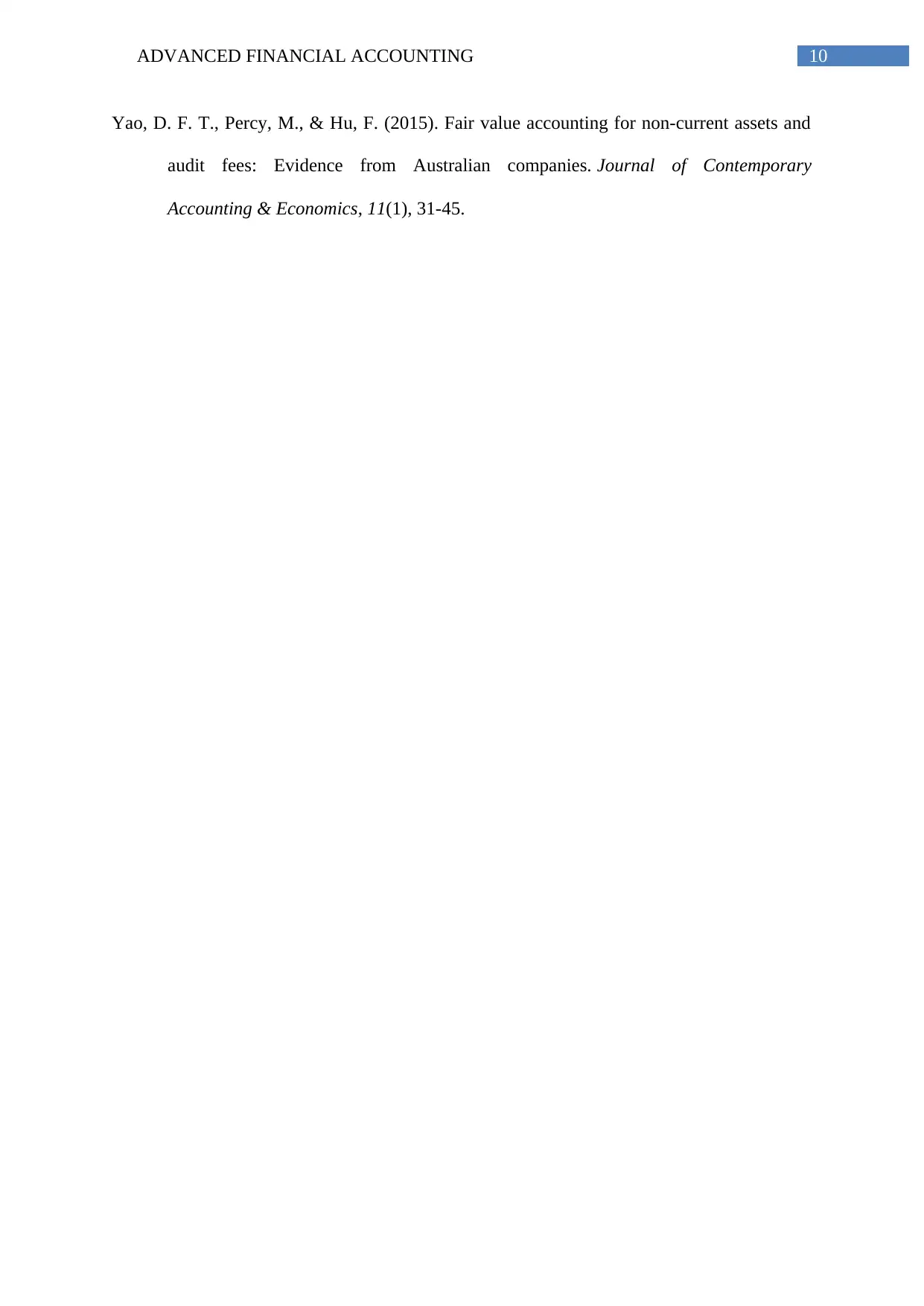
10ADVANCED FINANCIAL ACCOUNTING
Yao, D. F. T., Percy, M., & Hu, F. (2015). Fair value accounting for non-current assets and
audit fees: Evidence from Australian companies. Journal of Contemporary
Accounting & Economics, 11(1), 31-45.
Yao, D. F. T., Percy, M., & Hu, F. (2015). Fair value accounting for non-current assets and
audit fees: Evidence from Australian companies. Journal of Contemporary
Accounting & Economics, 11(1), 31-45.
1 out of 11
Related Documents
Your All-in-One AI-Powered Toolkit for Academic Success.
+13062052269
info@desklib.com
Available 24*7 on WhatsApp / Email
![[object Object]](/_next/static/media/star-bottom.7253800d.svg)
Unlock your academic potential
Copyright © 2020–2025 A2Z Services. All Rights Reserved. Developed and managed by ZUCOL.




